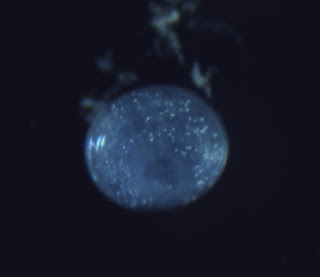Name that fungus!
 |
| The mysterious specimen |
Of all the beautiful larvae we collected that trip, one stood out to me. I pulled it from the watery sample, not knowing what it was. It kind of resembled an egg. Maybe it was an elusive deep-sea larva, I thought, but I wasn't sure what kind. We found 20 of them - sparkly blue orbs with gold flecks. A few of them were housed inside a loose mesh of spikes. My invertebrate-seeking mind concluded that the spikes must be sponge spicules, and we had found the first sponge larvae from the Arctic deep sea.
You can imagine my excitement when, months later, Kharis got a successful sequence from one of the mystery orbs. Here we go, I thought to myself, finally proof that we have found a sponge larva! I even had an idea what species it could be.
We ran the sequence against a massive online database. We held our breath while the algorithm searched for a match. The screen showed our results. The precious specimens were...
Well, not sponges, that's for sure. The list of results included some brown algae and two reasonably good matches in a group called "oomycetes." I was equal parts disappointed or confused.
I recognized the suffice "-mycete" from high school biology. Deep in the recesses of my mind, a definition emerged. Something ending in "-mycete" is usually a fungus. Had...had we found a marine fungus??
Lucky for me, I have a fungus guy. His name is Brandon, and we met in a training program for early-career researchers in Antarctica in 2018. Two years later, in 2020, I ran into him while doing field work in Svalbard. I'm telling you, friends, the world is small.
It took me a bit to find Brandon's current contact information, but once I told him I had an Arctic deep-sea fungus, he was all in. We've been e-mailing back and forth for weeks, brainstorming ways to identify the fungus - especially because it's probably a new species.
We ran into one pretty game-changing twist just a few days ago. I had ordered a set of DNA primers meant for fungi and was getting nowhere with them. Failed PCR after failed PCR left me utterly discouraged. Then I mentioned to Brandon that my top result for the specimen had been labeled an "oomycete" and his message back said it all.
"OooooooooooooooOoooOooooo" began the text.
Apparently, oomycetes are not true fungi. They're a weird group of organisms that act like fungi but are actually related to diatoms.
Friends, I really don't want to count chickens, but I'm even more excited about these specimens now. Oomycetes are extremely poorly studied, and we might be dealing with something novel. The next step is to hunt down a set of DNA primers I could use to sequence an oomycete and see if it works. I'm really enjoying this little side-quest into deep-sea diversity. Cross your fingers we get good results!
Comments
Post a Comment